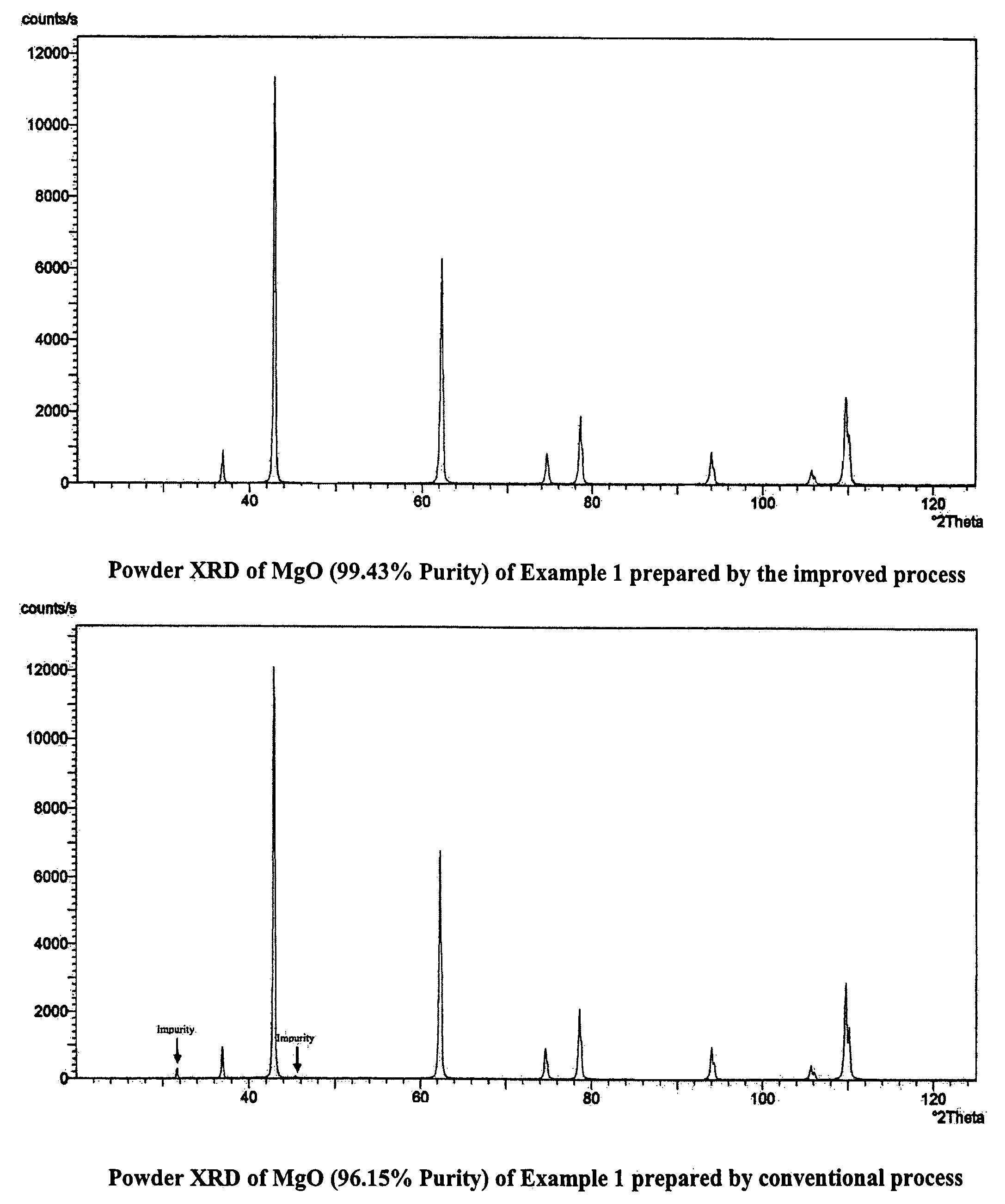Process for the preparation of magnesia (MgO) from crude Mg (OH)2
a technology of crude mg and magnesia, which is applied in the field of preparation of pure magnesia (mgo) from crude mg (oh) 2, can solve the problems of adversely affecting the properties of sintered magnesia, iron oxide, high impurity content of magnesite ore, etc., and achieves the effects of reducing boron impurities, easy washing and filtering, and reducing boron impurities
- Summary
- Abstract
- Description
- Claims
- Application Information
AI Technical Summary
Benefits of technology
Problems solved by technology
Method used
Image
Examples
example-1
[0118]1 L (4.79 moles of MgCl2) of end bittern having specific gravity of 1.324 and chemical composition Ca=0.504% (w / v), Mg=11.50%, SO4=ND, Na=0.41%, K=0.4%, B2O3=0.032 was partially evaporated by forced evaporation to reduce its volume to 800 ml. The resultant mass was cooled to room temperature followed by filtration to obtain 619.7 g crystalline magnesium chloride having chemical composition, Ca=0.22%, Mg=11.17%, B2O3=0.0147% and 370 ml of filtrate having specific gravity 1.338 and B2O3=0.0657%. 100 g (0.465 moles MgCl2) of the solid product was added into an NaOH solution (37 g NaOH of 98% purity in 50 mL water) and mixed under stirring. The temperature rose to 88° C. and the consistency became semi-solid. 147 g of the total of 182.7 g of reaction mass was taken for further processing. Of this 147 g, 100 g was directly calcined at 600° C. to obtain 41.28 g of calcined mass which was then treated with 50 mL water. The lumps crumbled and a uniform slurry was spontaneously formed ...
example-2
[0119]25 g of AR grade MgCl2.6H2O (0.122 moles) having 99% purity was thoroughly mixed with 9.5 g of hydrated lime (0.122 moles) [Ca(OH2)=95% assay] to form wet pasty solid mass having weight 34 g which on drying at 100-110° C. for two hours yielded 28.31 g dry mass. The loss on drying was 16.73%. This dried mass was calcined at 600° C. for two hours and after calcinations, 15.87 g of calcined material, giving a loss on ignition 43.94%, was collected. This calcined mass was subjected to wash with water, successively three times, to recover maximum amount of calcium chloride, simultaneously purifying the product also. In the first wash of 25 mL, the CaCl2 concentration was found to be 40.8%, recovering 10.2 g (0.092 moles) of CaCl2 which was 75.4% of the expected amount of calcium chloride (expected amount based on hydrated lime is 13.54 g; 0.122 moles). In all total 0.2 L of wash water was used for washing operation thus recovering total 11.8 g (0.106 moles; 87.1% yield) of CaCl2. A...
example-3
[0120]0.10 L (0.479 moles of MgCl2) of the end bittern of Example 1 was mixed under stirring with 30 g [0.385 moles of Ca(OH)2] of hydrated lime having assay 95% w / w (80.3% of the stochiometric requirement for Mg(OH)2 formation). The resultant slung was filtered under vacuum, which was slow. Wet cake weighing 95.12 g and 45 mL of filtrate having chemical composition: CaCl2=30.06%, [total 13.53 g (0.122 moles) CaCl2], Mg=2.94% were collected. Out of the total 42.73 g (0.385 moles) assumed CaCl2 formation, (based on hydrated lime addition), 31.6% of CaCl2 was obtained in this filtrate. Wet cake was calcined at 600° C. for three hours and 46.1 g of calcined material was obtained. The calcined material easily disintegrated in 70 mL of water. 62 mL of filtrate having 35% CaCl2 concentration and total 21.73 g (0.196 moles) of CaCl2, was obtained, which was 50.9% of the expected amount of calcium chloride. Another three washings, each of 50 mL (total 150 mL) were repeated using additive in...
PUM
| Property | Measurement | Unit |
|---|---|---|
| temperature | aaaaa | aaaaa |
| temperature | aaaaa | aaaaa |
| temperature | aaaaa | aaaaa |
Abstract
Description
Claims
Application Information
 Login to View More
Login to View More - R&D
- Intellectual Property
- Life Sciences
- Materials
- Tech Scout
- Unparalleled Data Quality
- Higher Quality Content
- 60% Fewer Hallucinations
Browse by: Latest US Patents, China's latest patents, Technical Efficacy Thesaurus, Application Domain, Technology Topic, Popular Technical Reports.
© 2025 PatSnap. All rights reserved.Legal|Privacy policy|Modern Slavery Act Transparency Statement|Sitemap|About US| Contact US: help@patsnap.com



